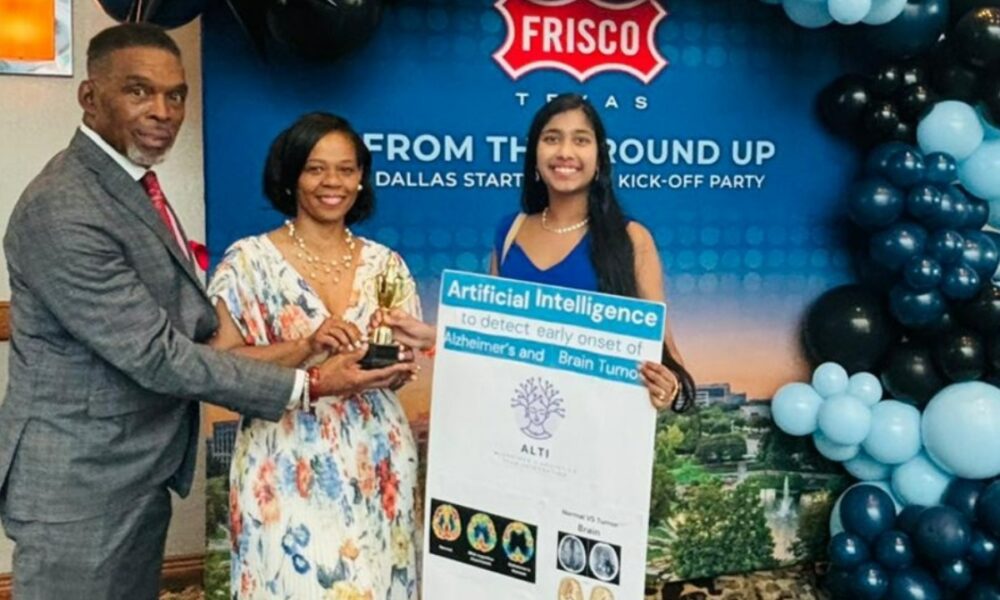**Headline: Highschooler Develops AI to Revolutionize Early Detection of Alzheimer's and Brain Tumors**

At just 12 years old, Nag Shivani Puram has achieved something remarkable—she’s developed an artificial intelligence (AI) project aimed at detecting the early onset of Alzheimer’s disease and brain tumors. As a junior in high school, Shivani’s work is not only a testament to her talent but also her commitment to making a meaningful impact in healthcare.
### The Inspiration Behind the Project
Shivani’s journey into the world of AI and healthcare began with a deep curiosity about the human brain and a desire to use technology for good. She was particularly struck by the challenges surrounding the early detection of neurodegenerative diseases like Alzheimer’s, which affects millions worldwide, and brain tumors, which are notoriously difficult to diagnose in their initial stages. The earlier these conditions are detected, the better the chances of successful treatment, making early diagnosis a crucial goal.
Seeing the potential of AI to revolutionize healthcare, Shivani decided to take on the challenge of developing a model that could assist in the early detection of these diseases. Her project is the culmination of months of research, coding, and testing, guided by a passion for using technology to solve real-world problems.
### The AI Project: An Overview
Shivani’s project leverages cutting-edge machine learning techniques, particularly deep learning, to analyze medical imaging data for early signs of Alzheimer’s disease and brain tumors. The project is based on the integration of two powerful types of neural networks: Convolutional Neural Networks (CNNs) and Recurrent Neural Networks (RNNs).
#### Convolutional Neural Networks (CNNs)
CNNs are a type of deep learning model particularly well-suited for analyzing visual data. They are widely used in image recognition tasks because they excel at detecting patterns and features in images. In Shivani’s project, CNNs process MRI scans, searching for patterns that may indicate the presence of early-stage Alzheimer’s disease or brain tumors. The CNNs help the model identify subtle differences in the brain’s structure and function that might be too minute for human eyes to detect.
#### Recurrent Neural Networks (RNNs)
While CNNs are adept at analyzing spatial data, RNNs are designed to handle sequential data, making them ideal for tracking changes over time. Shivani integrated RNNs into her project to analyze sequential MRI scans of patients. By evaluating how the brain changes across multiple scans, the model can better predict the onset of these conditions. This is particularly useful for Alzheimer’s disease, where changes in the brain happen gradually over time.
### The Solution: A Hybrid AI Model
The solution Shivani developed is a hybrid AI model that combines the strengths of Convolutional Neural Networks (CNNs) and Recurrent Neural Networks (RNNs) to enhance the early detection of Alzheimer’s disease and brain tumors.
- **Convolutional Neural Networks (CNNs):**
CNNs are particularly effective in the context of medical imaging, such as MRI scans, because they can automatically detect intricate patterns within the images. These patterns might be too subtle for a human radiologist to spot, especially in the early stages of diseases like Alzheimer’s or brain tumors.
In Shivani’s project, CNNs analyze MRI scans of the brain, identifying abnormalities in brain structure, such as the atrophy of regions often associated with the early onset of Alzheimer’s, or unusual masses that might indicate the presence of a tumor. The CNN processes these images through multiple layers, each focusing on different aspects of the image—edges, textures, shapes—culminating in a detailed and comprehensive analysis.
- **Recurrent Neural Networks (RNNs):**
While CNNs are excellent at processing static images, diseases like Alzheimer’s progress over time, and it’s essential to track changes in the brain’s structure over a series of scans. This is where Recurrent Neural Networks (RNNs) come in. RNNs are designed to handle sequential data and are particularly good at capturing temporal dependencies—essentially, how things change over time.
By integrating RNNs with CNNs, Shivani’s model can not only detect the presence of abnormalities in a single scan but also monitor how these abnormalities evolve across multiple scans taken over time. This ability to analyze changes is crucial because the progression of diseases like Alzheimer’s is gradual. By examining a sequence of scans, the RNN component of the model helps in predicting whether the subtle changes in brain structure are likely to develop into full-blown Alzheimer’s or if a detected mass could grow into a malignant tumor.
- **Training the Model:**
To train this hybrid model, Shivani used a dataset consisting of MRI scans from patients both with and without these conditions. The training process involved teaching the CNN to recognize patterns indicative of Alzheimer’s and tumors while the RNN learned to track the progression of these patterns over time. By doing so, the model became adept at distinguishing between healthy and diseased brain tissue.
- **Model Optimization and Testing:**
Once trained, the model was rigorously tested on new, unseen data to ensure its accuracy and reliability. Shivani implemented various optimization techniques, such as hyperparameter tuning and cross-validation, to fine-tune the model’s performance. The results were promising, with the model demonstrating a high level of accuracy in detecting early signs of both Alzheimer’s disease and brain tumors. This level of precision is crucial in clinical settings, where early detection can significantly improve treatment outcomes.
- **Real-World Application:**
The real power of this hybrid model lies in its potential for real-world application. Imagine a scenario where a patient undergoes routine MRI scans, and this AI model continuously monitors their brain health over time. The model could alert doctors to early signs of Alzheimer’s or the growth of a tumor before these conditions become symptomatic, allowing for earlier interventions that could slow down disease progression or even save lives.
Awards and Recognition
Shivani’s groundbreaking work has not gone unnoticed. During this summer internship she attended a Kauffman FastTrac Cohort, she will Graduate from this certified entrepreneur program on September,11th.,with honors awarded nationally for the best Artificial Intelligence Business Concept, in 2024. . Bert Robinson, the Program Director and Coach Trisstar Scallion, ED.M Program Manager, say “Shivani is an extraordinarily gifted student”.
Kauffman FastTrac is the world’s most prominent entrepreneur course, dedicated to empowering aspiring entrepreneurs.
Future Directions
Looking ahead, Shivani plans to continue refining her model and exploring additional avenues for its application with her team. She is particularly interested in integrating multimodal data, such as combining MRI and PET scans with genetic information, to improve the model’s predictive power. She also hopes to collaborate with medical professionals to test her model in clinical settings, with the ultimate goal of making her tool available for use in hospitals and clinics.
Additionally, Shivani is eager to share her work with the broader AI and medical communities. She has already begun writing a research paper detailing her methodology and findings, which she plans to submit to conferences and journals.





